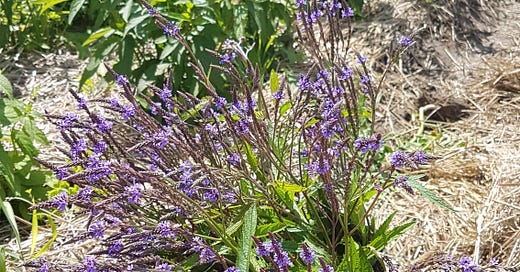Blue vervain is one of my main plant allies. The plant is tall and thin, with delicate, sublte, yet beautiful dark blue-purple flowers. It produces seeds that fly on the wind with little aerodynamic tufts, and wherever it lands, I let it grow, because it is really unobtrusive in the garden, and you can never have too much blue vervain in your life. More than ever, its message is relevant to us and our fast-paced culture: stop and rest. Stop and rest, says blue vervain. Whenever we’re too busy, whenever we’re rushing, whenever we’re filling our day with too many tasks. Stop and rest. The first time I heard this message, I was walking by the blue vervain plants in my garden, and that voice was like a strong nudge and firm insistence to stop in my tracks and spend some time in their shade for a while. And I did. It was such a strong feeling that came over me, it was as though the plant had reached into my mind and let its message bloom there, clear and crystalline as the forest streams. It was an especially potent message for me, who is usually very busy in the summer, burning the candle at both ends, usually burnt out by the fall. Thankfully I have a better balance this year.
I acknowledge that this may not be easy for everyone to do, especially parents with young children. Unfortunately many do not have the support systems to allow themselves this break, this rest. We need to bring back our tribes. We need matriarchal communities.
I write this as we wrapped up our latest session of the Women’s Herbalism Circle. We talked about blue vervain and had a wonderful time making flower essences.
Flower essences are the energetic imprint of flowers captured in pure spring water at the height of their bloom. They work on a subtle, energetic level to bring about healing or a shift in mindset. And if you’ve ever had a blue vervain flower essence, you know how potent it is. For me, it’s this feeling that starts at the top of the neck, flowing downwards, fully making me slump forward, as though my spine has lost all supporting structure (in the best relaxing, not-holding-any-tension kind of way). It leaves me with no desire to be productive for a while. In fact, blue vervain is especially indicated for those who are highly driven, which usually results in a lot of neck and shoulder tension. The person who can’t chill, who doesn’t know how to relax. I am this person. If this resonates with you, blue vervain might be an herb to work with.
Blue vervain is incredibly bitter. But there is this interesting complexity of taste within its bitterness. As a bitter, it has a nervine down-bearing action, in that it brings our consciousness out of our head and into our body. You can feel it in the way it works, as I described above, this sort of trickling relaxing feeling that happens from the neck-down. As though your tension was melting away, and grounding us in ourselves.
Bitter herbs are also highly valuable for digestion. Bitter receptors on the tongue send signals to the digestive system to prepare for digestion: this increases saliva secretions and stimulates bile production, readies the liver for processing food, coordinates the GI tract for proper timing of peristalsis. To effectively use bitters in this way, they are best taken 15 minutes before a meal, taken as a tincture, or simply nibbling on something bitter. You don’t even need very much: you just need to taste it. A few drops of a tincture will do.
We’ll explore bitters more in depth in our next Women’s Herbalism Circle. You’ll have the chance to walk around the garden, gather herbs, and make your own custom bitter concoction. Most bitters are made in a base of alcohol, but we also have apple cider vinegar for all you no-alcohol folks. Apple cider vinegar also makes really tasty bitters! If you’d like to join, or read more on it, follow the link here. I hope you can join us!


